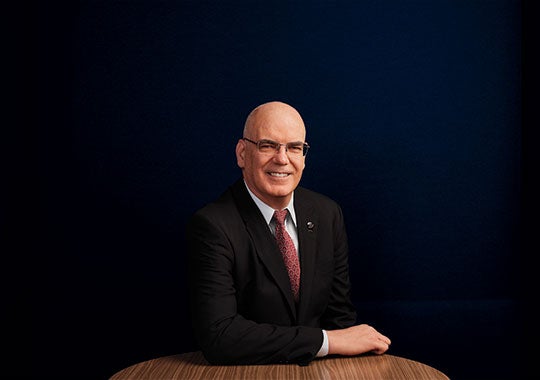Wide Open Space
The Rice Space Institute extends its reach.

Spring 2024
By Mike Williams
Space exploration is at a tipping point, and the Rice Space Institute is right where it needs to be — in the center. With support from Rice’s Office of Research, the institute connects the university with public and commercial space exploration communities in Houston and around the planet.
“It’s hard for people to fathom how much is going on and how much needs to be done,” says Rice astrophysicist David Alexander, the institute’s longtime director. “Houston is home to both NASA’s Johnson Space Center and the world’s first truly urban commercial spaceport. If we can’t do space here, we can’t do it anywhere.”
Along with hosting public lectures and events, the institute supports research on planetary formation and habitability to understand the origins of life in the universe, as well as human systems integration, which is key to supporting a human presence in space, on the moon and, ultimately, on Mars.
These days it’s hard to say ‘space’ in Houston without people thinking about Rice.
Rice’s long history with NASA and its strong connections to public and private space initiatives, including the recently announced Texas Space Grant Consortium, make it a draw for international visitors, Alexander says. “We are seeing a huge increase in international space delegations coming to our city, all of whom see Rice as a high-value partner.”
The institute has extended its reach through a partnership with the University of Edinburgh and a recent workshop at the Rice Global Paris Center. And through a Space Act Agreement with the Johnson Space Center, Rice will host up to 200 graduate students for the eight-week International Space University program this summer.
The institute has long been a key partner of the Houston Spaceport, a growing hub at Ellington Field, which is the joint installation shared by NASA and various military units near the Johnson Space Center. “Companies there are building spacesuits for microgravity and for the surface of the moon and Mars,” Alexander says. “They’re building a commercial lander for the moon and what may be the first-ever private space station. This has all happened in eight years. Things take time, but this is amazingly quick.”
Above all, the institute serves as a resource for students who wish to work on, or in, space. “These days it’s hard to say ‘space’ in Houston without people thinking about Rice,” he says. “That gives us great opportunities for our students.”
Learn more at rsi.rice.edu.
